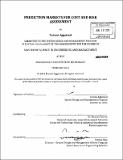| dc.contributor.advisor | Ricardo Valerdi. | en_US |
| dc.contributor.author | Aggarwal, Taroon | en_US |
| dc.contributor.other | Massachusetts Institute of Technology. Engineering Systems Division. | en_US |
| dc.date.accessioned | 2011-11-18T21:01:41Z | |
| dc.date.available | 2011-11-18T21:01:41Z | |
| dc.date.copyright | 2011 | en_US |
| dc.date.issued | 2011 | en_US |
| dc.identifier.uri | http://hdl.handle.net/1721.1/67211 | |
| dc.description | Thesis (S.M. in Engineering and Management)--Massachusetts Institute of Technology, Engineering Systems Division, System Design and Management Program, 2011. | en_US |
| dc.description | Cataloged from PDF version of thesis. | en_US |
| dc.description | Includes bibliographical references (p. 95-99). | en_US |
| dc.description.abstract | Several temporal and political factors can sometimes limit the effectiveness of traditional methods of project tracking and cost estimation. A large organization is susceptible to internal and external risks that are difficult to predict by a single person. Use of collective intelligence tools can help gather inputs from a crowd of people and help provide insight into future events with their collective wisdom. A prediction market is one such tool that provides an environment for traders to buy and sell contracts, whose values are tied to uncertain future events. Efficient prediction markets have been shown to outperform available polls and other forecasting mechanisms. This thesis focuses mainly on the features of a prediction market, its use in the context of a large organization and the steps needed for its implementation. We believe that prediction markets can be a useful supplementary tool along with the existing cost estimation and project management tools in a large organization. They can help aggregate information and identify any direct or indirect factors that can impact cost, or schedule estimates, or create risk for the completion of a project. Major design principles for implementation of prediction markets have been identified by the author based on seven mini case studies from different industries. The author also conducted three pilot studies at MIT and the observations from these have been used to identify best practices related to design and implementations of markets. We found increased involvement of participants and increased awareness in the projects to be one of the major benefits of prediction markets. From the case studies, research and data collected from simulations, we found positive evidence that prediction markets can supplement the use of current estimation and risk assessment methodologies when deployed correctly, and help keep a check on the pulse of an organization by preparing it for any future events or outcomes. | en_US |
| dc.description.statementofresponsibility | by Taroon Aggarwal. | en_US |
| dc.format.extent | 103 p. | en_US |
| dc.language.iso | eng | en_US |
| dc.publisher | Massachusetts Institute of Technology | en_US |
| dc.rights | M.I.T. theses are protected by
copyright. They may be viewed from this source for any purpose, but
reproduction or distribution in any format is prohibited without written
permission. See provided URL for inquiries about permission. | en_US |
| dc.rights.uri | http://dspace.mit.edu/handle/1721.1/7582 | en_US |
| dc.subject | Engineering Systems Division. | en_US |
| dc.title | Prediction markets for cost and risk assessment | en_US |
| dc.type | Thesis | en_US |
| dc.description.degree | S.M.in Engineering and Management | en_US |
| dc.contributor.department | Massachusetts Institute of Technology. Engineering Systems Division | |
| dc.identifier.oclc | 759082220 | en_US |
